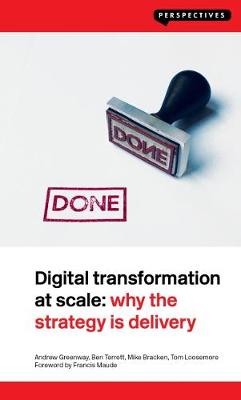Perspectives
1 total work
Organisations that grew up on the web have changed our attitude to the services we rely on every day. We expect them to work, be simple, cheap or free. They have done this by perfecting new technologies, practices, cultures and business models. However, organizations founded before the Internet aren't keeping pace - despite spending millions on IT. Faced with the digital revolution, many people working in large organisations instinctively see its consequences as another layer of complexity. To some of them, `digital' promises a better fax machine, a quicker horse, a brighter candle. In fact, digital is about applying the culture, practices, business models and technologies of the Internet era to respond to people's raised expectations. It is not a new function. It is not even a new way of running the existing functions of an organisation, whether those are IT or communications. It is a new way of running organisations. A successful digital transformation makes it possible not only to deliver products and services that are simpler, cheaper and better, but for the organisation as a whole to operate effectively in the online era.
This book is a guide to building a digital institution. Based on experience and not theory it explains how a growing band of reformers in businesses and governments around the world have helped their organisations pivot to this new way of working, and what lessons others can learn from their experience. It is based on the authors' experience designing and helping to deliver the UK government's successful `Government Digital Service'. The GDS was a new institution made responsible for the digital transformation of government, designing public services for the Internet era. It snipped GBP4 billion off the government's technology bill, opened up public sector contracts to thousands of new suppliers, and delivered online services so good that citizens chose to use them over the offline alternatives, without a big marketing campaign. Other countries, and private sector companies too, took note. Here is a simple map to navigate a path through the blockers, buzzwords and bloody-mindedness that doom analogue organisations.
This book is a guide to building a digital institution. Based on experience and not theory it explains how a growing band of reformers in businesses and governments around the world have helped their organisations pivot to this new way of working, and what lessons others can learn from their experience. It is based on the authors' experience designing and helping to deliver the UK government's successful `Government Digital Service'. The GDS was a new institution made responsible for the digital transformation of government, designing public services for the Internet era. It snipped GBP4 billion off the government's technology bill, opened up public sector contracts to thousands of new suppliers, and delivered online services so good that citizens chose to use them over the offline alternatives, without a big marketing campaign. Other countries, and private sector companies too, took note. Here is a simple map to navigate a path through the blockers, buzzwords and bloody-mindedness that doom analogue organisations.
